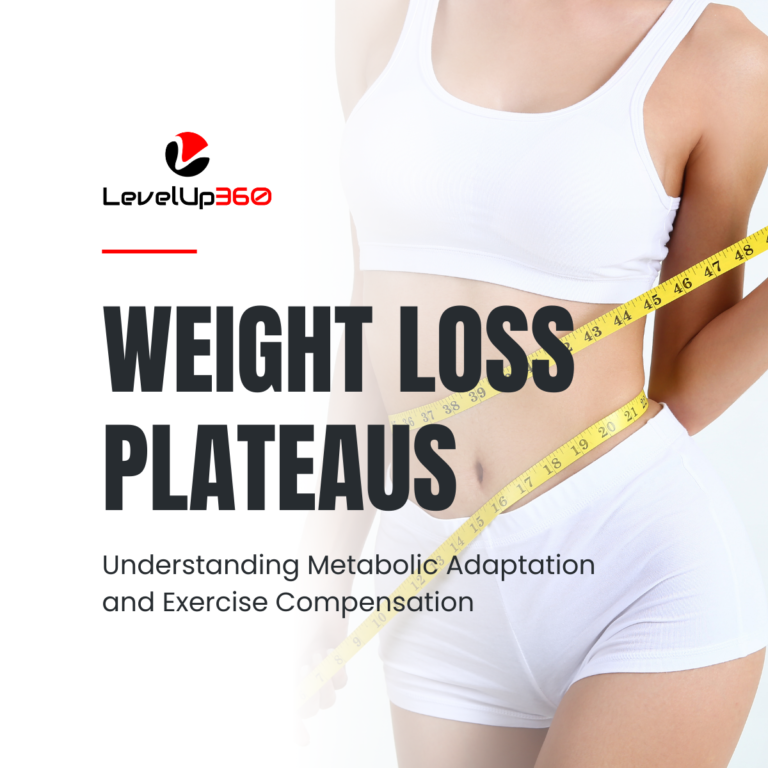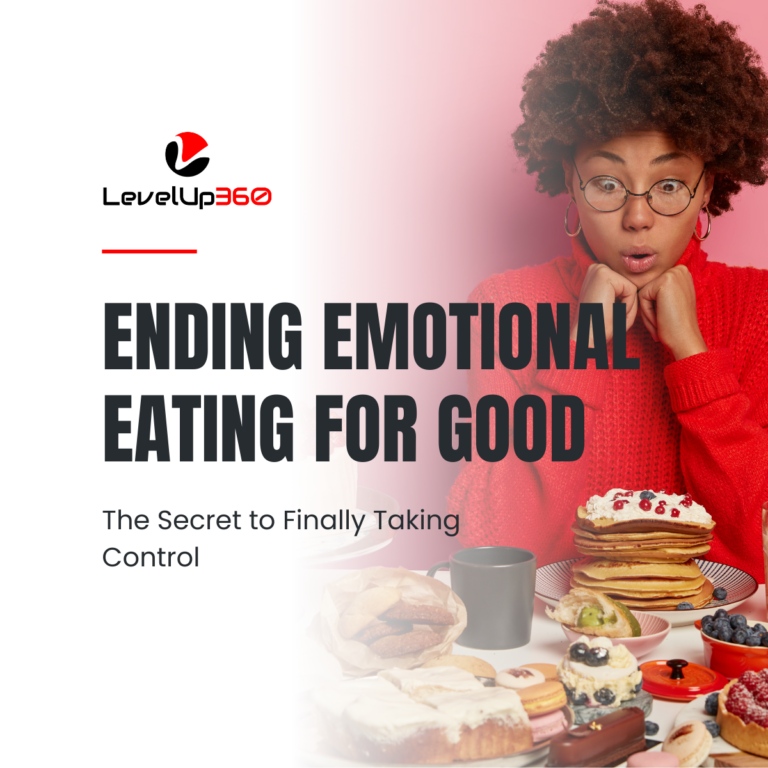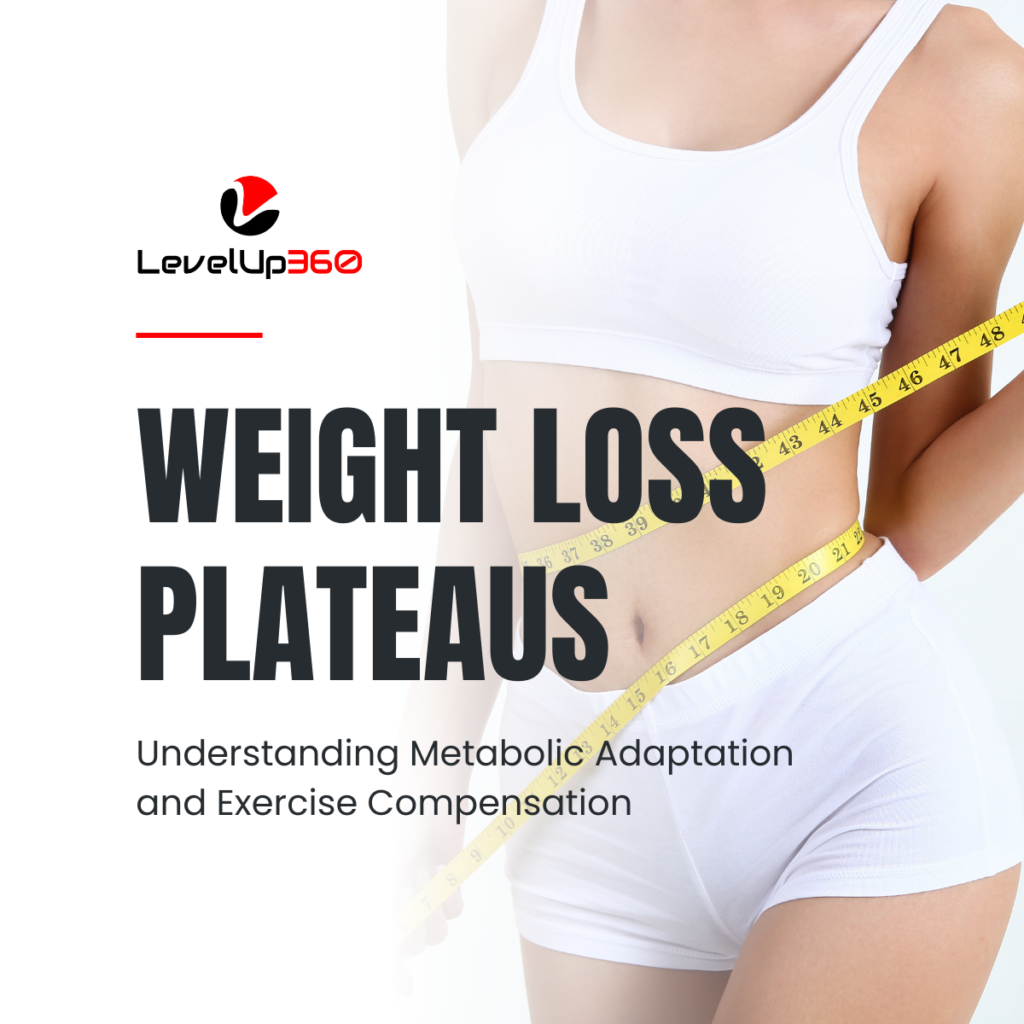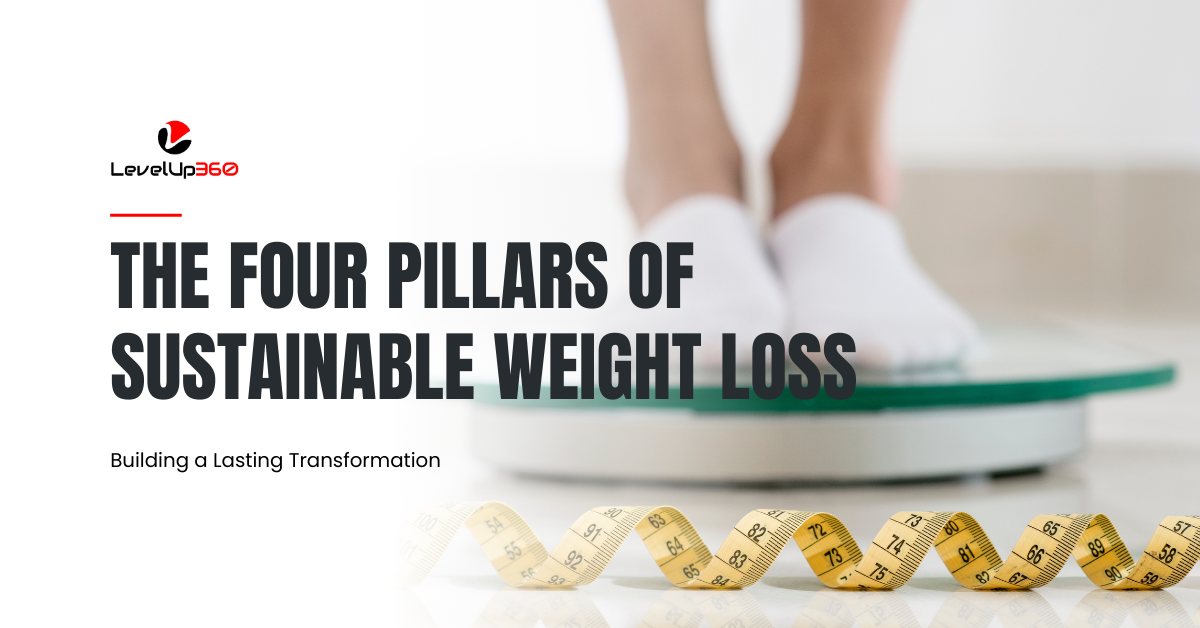
The Four Pillars of Sustainable Weight Loss: Building a Lasting Transformation
In a world that often glorifies quick fixes and fad diets, the pursuit of sustainable fat loss stands as a beacon of health and well-being. The journey to shed excess weight and embrace a healthier lifestyle is a transformative one, demanding more than a fleeting commitment. It necessitates the construction of a strong and enduring foundation, consisting of four essential pillars. These pillars, when integrated cohesively, create a roadmap for successful and lasting fat loss.
In this article, I will explain the principles behind each of the four pillars so you can build upon them and integrate them into your life to pave the way for successful and sustainable fat loss. Remember, this is not about quick fixes but rather long-lasting transformation.
The journey to shed excess weight and embrace a healthier lifestyle is a transformative one, demanding more than a fleeting commitment
The Power of Environment:
Your willpower is not going to surpass your environment.
If you are struggling and you always find a way to get back to where you started, a big factor of that is because your environment is not so conducive. If your friends are all stuck, it’s no wonder you’re stuck. Stuck people stay stuck, and they keep everyone around them stuck. You cannot willpower your environment.
Imagine your willpower as a sailboat navigating the sea of life. Your environment is the ocean, and the winds that fill your sails are the factors that determine your progress. If winds are weak and inconsistent, no amount of willpower will move your boat forward.
Your environment can either support or hinder your journey. It’s like trying to grow a beautiful garden in soil that’s full of weeds and rocks. No matter how diligently you tend to your plants (representing your efforts), the unfavourable environment will make it incredibly challenging to succeed.
Building a Solid Foundation:
The faster you look at your transformation (trying to lose this weight and keep it off) like a house, the better off you’ll be. Because too often, most people ask, “Well, let me ask you if I could just snap my fingers and I can just make the 15 or 30kg disappear, would it stay off?” Most people go, “Oh, well, no, cause I’d revert back to old behaviours, I would sabotage, I would…”
All these things. Right. Well, my question is, if you just said, magic genie powers wouldn’t solve your problems, why are we trying to white-knuckle through weight loss? We need to fix that foundational piece of this.
Imagine your weight loss journey as the construction of a house. Before you can build up, you need to ensure that the foundation is solid. Skipping this crucial step is like building the upper floors of a house without first pouring a sturdy concrete base. It might seem fine for a while, but sooner or later, the entire structure will crumble.
The foundation here represents the core pillars of your fat loss journey, which we’ll discuss in detail. These pillars are essential for not only shedding those extra pounds but also maintaining your progress over the long term.
Pillar 1: Setting Yourself Up For Success

Pillar number one is what I call setting yourself up for success. Most people are actually not setting themselves up for success at all. Most people actually fail right out of the gate because of their habits, their expectations, and everything that’s going into this.
To make it easier, let’s break this pillar down into sub-categories, starting with expectations:
Setting Realistic Expectations: Expectations play a monumental role in determining your success on a weight loss journey. In fact, managing your expectations is often more critical than the specifics of your diet or exercise regimen.
Consider this: If you set out on a weight loss journey expecting immediate, dramatic results, you’re setting yourself up for disappointment and frustration. It’s akin to planting a tree and expecting it to bear fruit the very next day. Weight loss is a gradual process, and understanding this is crucial to staying motivated and committed.
Amazing fat loss progress is right around a quarter to half a kilo a week lost consistently, averaged over months. It’s important to understand that weight loss is not a linear journey. Your weight can fluctuate due to various factors, including water retention, muscle gain, and even hormonal changes. These fluctuations can make it appear as though you’re not making progress when, in reality, you are.
Let’s be clear: losing a quarter to half a kilo per week is an incredible achievement. It might not sound as flashy as some crash diet promises, but it’s the kind of progress that can be maintained and built upon over the long term. It’s the slow and steady approach that wins the race in the end.
Sustainability is Key: One of the most overlooked aspects of any weight loss plan is its sustainability. People often gravitate toward extreme diets or exercise regimens that they can’t realistically maintain over the long haul. It’s like sprinting a marathon; you might have a burst of speed at the beginning, but you’ll quickly burn out.
So, what’s the key to success? Creating a plan that you can stick with not just for a few weeks or months, but for years to come. If you can’t see yourself following a particular diet or workout routine for an extended period, it’s time to reconsider your approach.
Consider this: if your weight loss plan is so restrictive that it feels like a punishment, how likely are you to stick with it? The more enjoyable and sustainable your approach, the higher your chances of success. Weight loss shouldn’t be a temporary fix; it should be a lifelong commitment to a healthier you.
The Role of Mindset: Your mindset is the silent force that can either propel you toward your goals or hold you back. It encompasses your beliefs about yourself, your relationship with food, your reactions to setbacks, and your ability to stay motivated even on tough days.
Addressing your mindset is often the most neglected aspect of weight loss, yet it’s arguably the most crucial. If your mental and emotional foundation isn’t solid, even the best-laid plans can crumble.
Imagine this as the unseen support structure of your weight loss journey. It’s the scaffolding that holds everything together. If you don’t address your mental and emotional well-being, you risk sabotaging your progress, falling prey to emotional eating, and continually battling self-doubt.
In summary, pillar number 1 involves three critical components: managing your expectations, prioritizing sustainability, and nurturing a resilient mindset. By laying this strong foundation, you’re equipping yourself for a successful, long-lasting weight loss journey.
Pillar 2: Nutrition
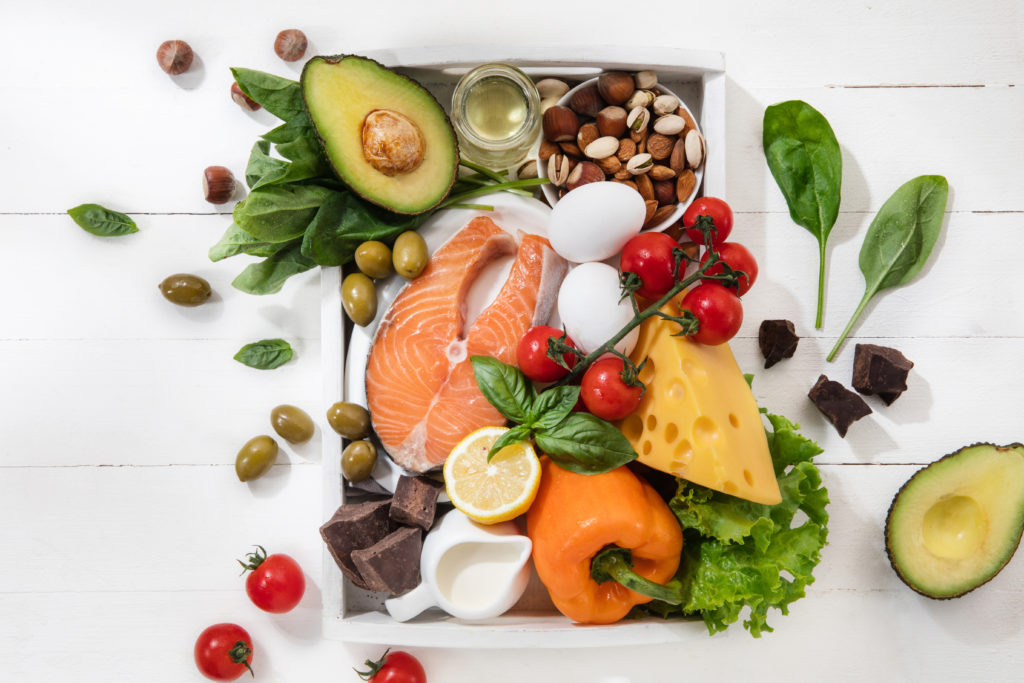
When we talk about weight loss and transforming your body, nutrition emerges as one of the fundamental pillars that support your journey. It’s not just about counting calories or eating less; it’s about nourishing your body intelligently to achieve your goals while also ensuring you remain healthy and satisfied throughout the process.
Calorie Deficit: At the core of your nutrition strategy is the concept of a calorie deficit. This term may seem intimidating or overly scientific, but it’s essentially the difference between the calories you consume and the calories your body expends. To put it simply, you need to consume fewer calories than your body burns to lose weight.
Understanding this concept is crucial because it demystifies the weight loss process. It highlights the importance of balance in your energy equation. By consistently eating fewer calories than your body requires, you create the conditions for fat loss.
But remember, it’s not about drastically slashing your calorie intake to unsustainable levels. This can lead to feelings of deprivation, fatigue, and even nutritional deficiencies. A moderate, sustainable calorie deficit is the key. It allows you to lose weight while still feeling energized and satisfied.
Prioritizing Protein and Whole Foods: Now, let’s talk about what makes up those calories you consume daily. Not all calories are created equal, and this is where the importance of prioritizing certain types of foods comes into play.
- Protein: Often referred to as the building block of the body, protein plays a vital role in your weight loss journey. Not only does it help repair and build lean muscle mass, but it’s also incredibly satiating. This means that when you include an adequate amount of protein in your diet, you’re less likely to experience those insatiable hunger pangs that can derail your progress. Moreover, protein requires more energy (calories) for digestion and absorption compared to carbohydrates or fats. This is known as the thermic effect of food (TEF), and it means that you’re actually burning extra calories by simply consuming protein.
- Whole Foods: Whole foods are nature’s gift to your health and weight loss goals. They are minimally processed and packed with essential nutrients, including vitamins, minerals, fibre, and antioxidants. Whole foods keep you feeling full, provide steady energy, and support overall well-being. Incorporating more whole foods into your diet not only helps you stay on track with your calorie goals but also promotes long-term health. Think colourful fruits and vegetables, whole grains, lean proteins, and healthy fats like avocados and nuts. These foods offer a symphony of nutrients that work in harmony to support your body’s functions.
Sustainability and Practicality: One of the biggest misconceptions about weight loss is that it requires a radical departure from your current way of eating. While some changes may be necessary, the key to lasting success is sustainability.
A diet that’s too restrictive or extreme might yield short-term results, but it’s rarely maintainable over the long haul. Imagine trying to eat the same bland, uninspiring meals day after day, or completely cutting out entire food groups. It’s not a recipe for joy or success.
What you should aim for is a nutritional plan that you can comfortably adopt as a lifelong approach. Weight loss is a journey that extends beyond just shedding pounds; it’s about cultivating a healthier relationship with food. It’s about finding a way of eating that not only helps you reach your goals but also allows you to enjoy life and its culinary pleasures.
This means that your diet should be practical and adaptable to various situations. It should accommodate social gatherings, celebrations, and those occasional indulgences without guilt. When your diet is sustainable, it’s easier to maintain your weight once you’ve reached your goals.
Balancing Carbs and Fats: The macronutrients – carbohydrates, fats, and proteins – form the foundation of your diet. While protein has already been emphasized, it’s crucial to strike a balance between carbs and fats as well.
- Carbohydrates: Carbs are your body’s primary source of energy. They’re essential for fuelling your daily activities, especially if you engage in regular exercise. opt for complex carbohydrates like whole grains, vegetables, and legumes. These carbs provide steady energy and support your overall health.
- Fats: Fats have often been vilified in the past, but they play a vital role in your body. Healthy fats, such as those found in avocados, olive oil, and fatty fish, are essential for cell function, hormone production, and the absorption of fat-soluble vitamins. Including these fats in your diet not only adds flavour to your meals but also helps you stay satisfied.
It’s important to note that there’s no one-size-fits-all approach to macronutrient ratios. Your ideal balance of carbs, fats, and proteins may vary depending on your body, activity level, and personal preferences.
Incorporating Your Favourite Foods: Lastly, let’s talk about one of the most overlooked aspects of a successful nutrition plan – enjoying your favourite foods. Yes, you read that correctly. Weight loss isn’t about banishing beloved treats; it’s about finding ways to incorporate them sensibly.
Deprivation often leads to cravings and emotional eating. By allowing yourself the occasional indulgence within your calorie limits, you satisfy your desires without derailing your progress. Imagine savouring a small piece of chocolate, a scoop of ice cream, or a slice of pizza, all while staying on track with your goals.
This approach fosters a healthy relationship with food, making your weight loss journey more enjoyable and sustainable. It’s not about restricting yourself from the foods you love; it’s about learning how to include them in moderation.
In essence, nutrition is far from a one-dimensional aspect of your weight loss journey. It’s a multifaceted pillar that encompasses calorie management, food quality, sustainability, and flexibility. By understanding these principles and adopting them into your daily life, you’ll not only achieve your weight loss goals but also cultivate a healthier relationship with food that lasts a lifetime.
Pillar 3: Physical Activity

Now, let’s delve into the essential component of your transformation journey – training. It’s crucial to approach your training regimen with a clear and focused mindset. Here’s what you need to know:
Fundamental Strength Training: When it comes to training, simplicity is key. You don’t need to engage in complex, acrobatic workouts that involve BOSU balls, single-leg squats, jumping spins, or other fancy manoeuvres. What you need is fundamental strength training. This means incorporating exercises that are tried and true: pushing, pulling, squatting, and hinging. These movements are the building blocks of strength and should form the foundation of your training routine.
You don’t have to make this process exciting or flashy. In fact, it’s often the less glamorous routines that yield the best results. Focus on getting stronger, preventing injuries, and improving your overall functional fitness. When you pick up your groceries or perform daily activities, you’ll notice the benefits of this fundamental strength training. Aim to dedicate between two to four days a week to these workouts, depending on your fitness level and goals.
Move More: Training isn’t confined to the gym or structured workouts alone. It’s also about leading an active lifestyle. Find opportunities to move more throughout your day. Go for walks, choose to park further away at the grocery store, and take the stairs instead of the elevator – these seemingly small adjustments can add up and contribute to your overall fitness.
Remember, your training regimen doesn’t need to be overly complicated. Don’t fall into the trap of thinking that doing more will speed up your progress. In fact, it’s often counterproductive to rush through a process that’s naturally meant to be gradual. Instead, focus on fundamental strength training and incorporating more movement into your daily life. This approach is sustainable and will yield lasting results. Keep it simple and stay committed to the basics. That’s the key to success in the training component of your transformation journey.
Pillar 4: Accountability and Support

Support and accountability are the cornerstones of transformation and lasting change. They serve as the essential scaffolding upon which your journey to a healthier, more fulfilling life is constructed.
You’ve probably heard the saying, “It takes a village to raise a child.” Well, the same principle applies to achieving your health and fitness goals. Significant change rarely occurs in isolation. Having a support system around you is like having a safety net that catches you when you stumble. Your journey becomes a collective effort, making it easier to persevere through challenges.
The Power of Your Environment: Your surroundings exert a profound influence on your behaviour and choices. No amount of willpower can consistently override a detrimental environment. If you find yourself repeatedly falling back into old habits or struggling to make progress, it’s often because your environment isn’t conducive to your goals. Your surroundings need to support, not sabotage, your efforts.
Think of it this way: if your friends or colleagues have habits that conflict with your health goals, it’s challenging not to be influenced by their choices. You become like those you associate with, and this isn’t just a casual observation—it’s supported by science. Our DNA and protein expressions respond to our social environment. If you’re surrounded by individuals who aren’t aligned with your goals, it becomes incredibly difficult to maintain your course.
Self-Sabotage and Your Environment: Many people experience a strange phenomenon: they attend a seminar, a workshop, or a fitness retreat and experience a remarkable transformation. They return home feeling invincible, but soon after, they revert to their old ways. This isn’t due to a lack of willpower or motivation; it’s because they’ve re-entered their old environment, which actively encourages their previous behaviours.
To put it bluntly, you can’t out-willpower a toxic environment. The power of your surroundings is too strong. This is why making changes stick often requires making corresponding changes to your environment. It’s about setting up your surroundings for success.
Drifting When Left Alone: Humans are creatures of habit, and we’re naturally inclined toward what’s familiar and easy. Even when we achieve our goals, our nervous system craves the comfort of our old habits. This natural inclination to revert to old behaviours is why so many people find themselves losing weight only to gain it back later.
It’s like drifting in a boat without an anchor—gradually, you return to your previous state. Left to your own devices, without a support system and accountability in place, you might find yourself back where you started, wondering how you got there.
If you genuinely want to increase your chances of reaching your goals, whether it’s shedding those stubborn pounds or transforming your lifestyle, you must prioritize accountability and support.
These pillars will provide you with the strength to stay on course, help you resist the pull of an unsupportive environment, and prevent you from drifting back into old habits. Remember, your journey becomes far more achievable and sustainable when you embrace the power of accountability and support.
Conclusion

In the pursuit of sustainable weight loss, the foundation upon which your journey is built determines its sustainability and success. The four pillars of realistic expectations, nutritional balance, physical activity and exercise, and rest and recovery, create a robust framework that supports your transformation. Embrace these pillars not as isolated components but as interconnected elements that together form the bedrock of lasting change.
Remember that sustainable weight loss is not solely about the destination; it’s about the journey of self-discovery and growth. Every step you take, every choice you make, contributes to your progress. Be patient, be kind to yourself, and celebrate both small victories and setbacks as they come.
With the four pillars firmly in place, you possess the tools to build a healthier, stronger, and more confident version of yourself.
Recommended reading
Recommended reading
Additional Resources
Feeling in control of your health
If you are interested in improving your health and wellness, check out other resources such as Our Blog, Free Resources and/or join our private Body-Mind Transformation Secrets Community on Facebook, and The 360 Transformation Blueprint Podcast on Spotify and go on an even deeper dive with me to uncover how to succeed in your health and wellness goals.
You may also be interested in our Sleep Secrets Cheat Sheet. It is a great resource with strategies to fix and optimize your sleep which is crucial to succeeding in your health and wellness goals.
Resources
Pictures


